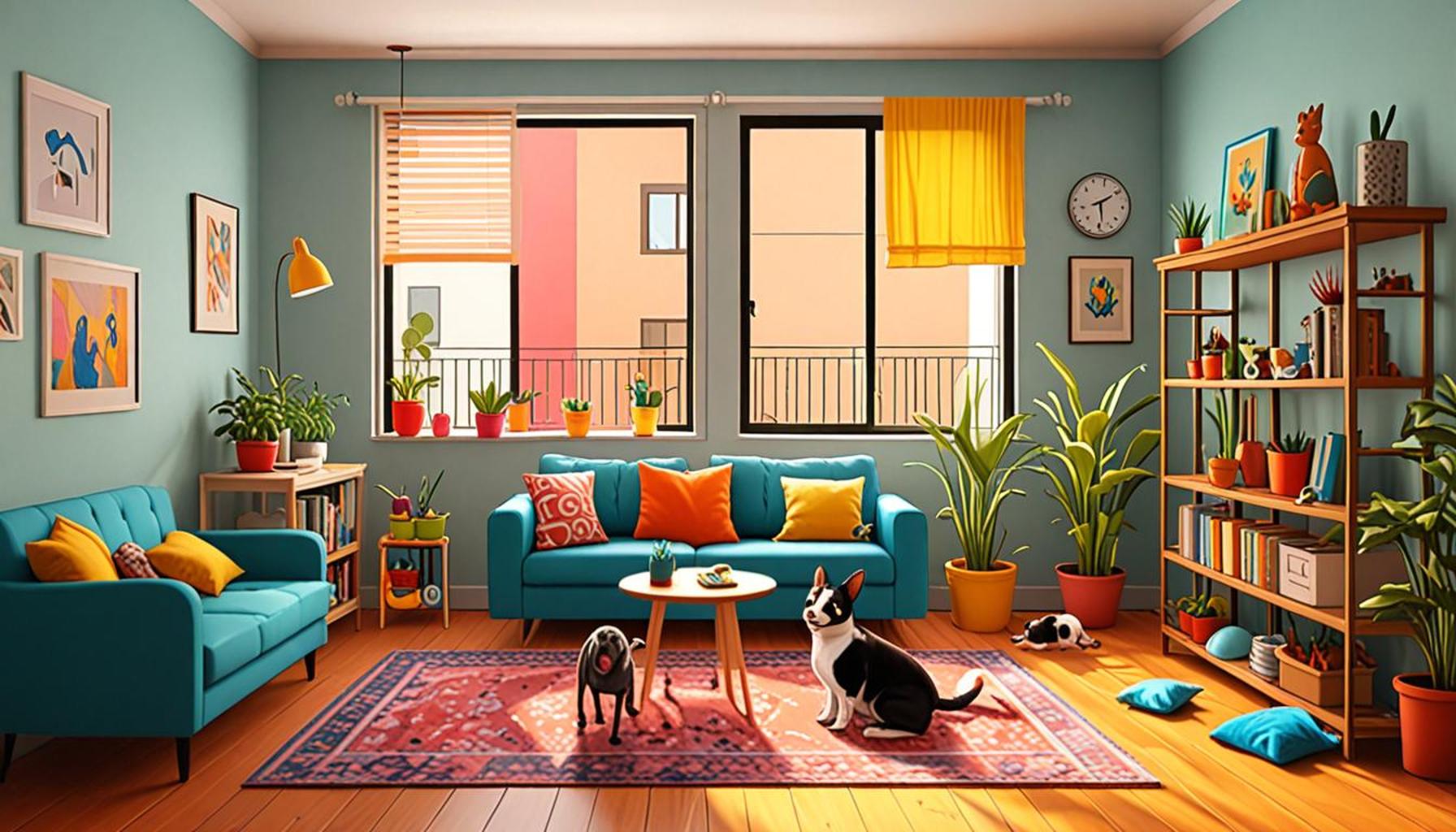The Challenges of Pet Adoption in Apartments: Tips for Creating a Suitable Environment

The Challenges of Pet Adoption in Apartments
Adopting a pet can be a highly rewarding experience, offering companionship, love, and a sense of responsibility. However, this joy often comes with unique hurdles, particularly for those residing in apartments. With limited space, noise restrictions, and available amenities, potential pet owners must navigate various challenges to ensure their furry companion feels at home.
Many prospective pet parents often confront essential questions about their ability to provide a suitable environment for their future pet. For instance:
- Which breeds are best suited for apartment living? Some smaller or less active breeds, such as French Bulldogs or Cavalier King Charles Spaniels, can thrive in limited spaces due to their calm demeanor and smaller size.
- How can I keep my pet entertained in a smaller space? Interactive toys, puzzle feeders, and frequent play sessions can engage pets mentally and physically, helping to combat boredom.
- What should I do about outdoor access for walks and exercise? Regular walks, even multiple times a day, are essential. Utilizing local parks or dog-friendly areas can also provide ample space for your pet to romp around.
Apartments often necessitate specific adjustments to enhance the well-being of both pets and owners. Living in close quarters means:
- Being considerate of neighbors: Noise can be an issue, especially with barkers. Training your dog to minimize excessive noise and ensuring your cat has proper outlets for energy can lead to a more harmonious living environment.
- Minor adjustments to lifestyle: Compromises may include limiting gatherings to accommodate pet needs or scheduling extra time for exercise and play sessions.
- Creating a safe and engaging environment for pets: Setting up pet-friendly areas within your home, complete with scratching posts, chew toys, and cozy resting spots, can help create a stimulating environment.
By equipping yourself with knowledge and practical tips, you can overcome these obstacles. Implementing solutions such as a pet schedule or organizing pet playdates fosters a nurturing atmosphere for your new companion.
Ultimately, the key to successful pet ownership in an apartment lies in preparation and understanding. By considering these factors, future pet owners can create a comfortable, enriching home for their furry friends while maintaining harmony in their living space.

DISCOVER MORE: Click here to learn how pets can change your life
Understanding the Unique Needs of Apartment Pets
For many pet owners living in apartments, understanding their furry friends’ unique needs is vital to ensuring a harmonious coexistence. Unlike those residing in spacious homes with yards, apartment dwellers must be savvy about how to fulfill their pet’s requirements within a more confined area. This involves being aware of the space limitations, attention needs, and exercise requirements that different animals may have.
It’s essential to recognize that not all pets adapt well to apartment living. Factors such as breed characteristics, size, and energy levels can significantly influence a pet’s ability to thrive in smaller spaces. Here are some essential considerations:
- Choosing the Right Breed: Certain dog breeds are more suited to apartment life than others. Smaller breeds, such as Chihuahuas or Dachshunds, typically require less space and can adjust well to urban living. Even within larger breeds, there are individuals with calmer temperaments that may do better in close quarters.
- Activity Levels: Dogs and cats with high energy levels require more structured physical activities. Engaging activities like daily walks, visits to dog parks, or even games like fetch can ensure pets get the exercise they need. Consider breeds like the Greyhound, which, despite their size, are known for being “couch potatoes” when not exercising.
- Socialization Needs: For pets that thrive on social interaction, living in an apartment can mean fewer opportunities for natural interactions with other animals. Make sure to regularly provide playdates or opportunities for pets to visit dog parks or common areas where they can socialize with nearby pets.
While the challenges of apartment living can be significant, understanding these factors is half the battle. Pet owners can create a suitable environment by employing some effective strategies. For instance, implementing a consistent exercise routine can alleviate behavioral issues caused by boredom. Taking dogs for walks at least twice a day can also enrich their social skills and expose them to different environments.
Moreover, adapting the home environment is equally crucial. Pet-friendly furniture, safe spaces, and designated play areas can make living with pets much easier. Innovative storage solutions can help organize pet supplies without cluttering common spaces. Always ensure that hazardous items are out of reach and that there are secure areas for pets to relax.
As you navigate the challenges of pet adoption in apartments, remember that preparation is key. Gathering knowledge about breed-specific needs, potential environmental adjustments, and creating engaging spaces will ultimately enhance the quality of life for both you and your pet.
When adopting pets in apartment settings, it’s crucial to recognize the specific challenges that can arise. Limited space, lack of outdoor access, and the need for social stimulation are just a few factors that can affect both the pet’s well-being and the owner’s experience. Here’s where understanding the unique demands of having a pet in an apartment becomes essential.Space Constraints: Apartments often come with limited square footage, making it vital to create a comfortable environment that accommodates your pet’s needs. Consider utilizing vertical space with shelves or cat trees for climbing and exploring. Small dogs may require less room to roam, but they still need areas to play and rest. Choosing furniture that doubles as a pet retreat, like a stylish dog bed that blends with decor, can also enhance the living space.Exercise and Socialization: Pets need regular exercise to maintain health and happiness, which can be a bit tricky when outdoor options are limited. Regular walks are essential, but consider dog parks or nearby trails for a more stimulating environment. Finding local pet-friendly venues for socialization, like cafes or community events, can also provide your pet with valuable interaction. Noise and Behavior Management: Living in close quarters can amplify noise, which can be disruptive for both pets and neighbors. Training your pet effectively helps minimize excessive barking or meowing, making for a more harmonious living situation. Providing enriching toys, puzzle feeders, and interactive play can help channel energy positively, reducing the chances of unwanted behaviors.Through thoughtful planning and the right resources, pet adoption in apartments can be a fulfilling experience for both pets and their owners. Ensuring that your living space meets the unique needs of your furry friends is not just beneficial—it’s essential for their overall happiness and well-being. To further explore the intricacies of creating a suitable environment for pets in apartments, consider delving into providing mental stimulation or adopting a breed that is more adaptable to smaller spaces. Understanding these elements can transform challenges into opportunities for a joyful cohabitation with your beloved pet.
DIVE DEEPER: Click here to learn more about effective dog training techniques
Adapting Your Apartment to Meet Your Pet’s Needs
Creating a suitable environment for a pet in an apartment can feel daunting, but with thoughtful adjustments, pet owners can transform limited spaces into vibrant homes full of life and comfort. First and foremost, understanding environmental enrichment is essential. This means offering diverse activities and stimuli that satisfy a pet’s instincts and intellectual needs. Pets, especially dogs and cats, thrive when they have opportunities to explore, play, and exercise their minds.
One way to enhance your pet’s living conditions is by incorporating interactive toys and puzzles. These can keep a pet engaged and mentally stimulated when left alone, and they can reduce the risks of destructive behavior born from boredom. For instance, treat-dispensing toys challenge pets to think and solve problems while rewarding them with treats. Studies have shown that engaging pets in mentally stimulating activities can lead to happier pets and less anxiety-related actions.
Additionally, creating designated spaces within your apartment can help organize both your life and your pets. Consider setting up a cozy, inviting nook with a bed, toys, and blankets for your pet to retreat to when they need downtime. This can reduce stress for both pets and owners by giving pets a clear area they can claim as their own. Additionally, vertical space can be creatively utilized, especially for cats, by installing cat trees or wall shelves that allow them to climb and perch at different heights, simulating an outdoor environment.
The Importance of Clear Boundaries
Clear boundaries are also crucial when living with pets in an apartment setting. Using baby gates can help set limits between different areas of your home, particularly if you have rooms that should remain off-limits for your pet. This helps maintain a peaceful environment, especially if you need to establish areas for work or relaxation that might not be suitable for your pet’s activity levels.
Another significant aspect to consider is noise control. Apartments can often be noisy, which can be stressful for pets. To mitigate this, seek out solutions such as sound-proofing methods—like acoustic panels or rugs that absorb sound. Creating a calm atmosphere can ease your pet’s anxiety and stress.
Communicating with Your Landlord
When adopting a pet in an apartment, it’s also vital to have an open line of communication with your landlord or property manager. Always have your pet policies clarified, including any breed, size, or noise restrictions. Discussing these matters upfront can prevent potential conflicts and ensure that both you and your neighbors cohabitate harmoniously.
Moreover, actively participating in your apartment community can be beneficial. Many urban apartments have amenities such as dog parks or pet-friendly areas. Engaging with fellow pet owners by organizing communal activities—like dog-walking groups or neighborhood playdates—fosters community and provides your pet with valuable socialization opportunities.
Finally, keep the safety of your pet a priority. Always conduct regular checks around your apartment to ensure that household hazards are minimized, such as toxic plants or dangling cords that curious pets might chew on. An aware and prepared owner not only enhances their pet’s living experience but also creates a peaceful environment conducive for all residents.
DISCOVER MORE: Click here for insights on pet nutrition
Conclusion
Adopting a pet in an apartment setting comes with distinct challenges, but it also opens the door to a rewarding companionship that enriches both your life and that of your furry friend. Understanding how to create a suitable environment can make a significant difference in overcoming issues related to space limitations and noise. As we explored, the key lies in environmental enrichment, which fosters mental stimulation through toys and interactive activities, ensuring pets remain engaged and happy.
Additionally, by establishing clear boundaries, you can maintain a harmonious living space that benefits both you and your pets. Taking proactive measures, such as sound-proofing and designing cozy nooks, can further alleviate stress levels and contribute to a peaceful atmosphere. Remember, communication with your landlord is paramount; it cultivates a positive relationship and sets clear expectations regarding pet policies.
Moreover, immersing yourself in your apartment community can create a support network among fellow pet owners, presenting opportunities for socialization for both pets and their owners. Adopting a holistic approach towards pet care in an apartment not only enhances the pet-parent relationship but also paves the way for fewer challenges and more joy in daily living. As you consider adding a new member to your household, remember that with thoughtful planning and creativity, a pet can thrive beautifully in any apartment setting.


